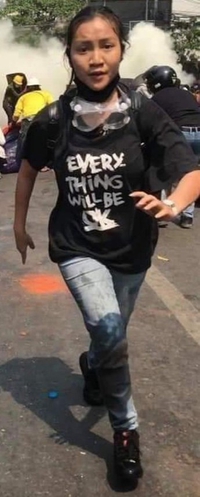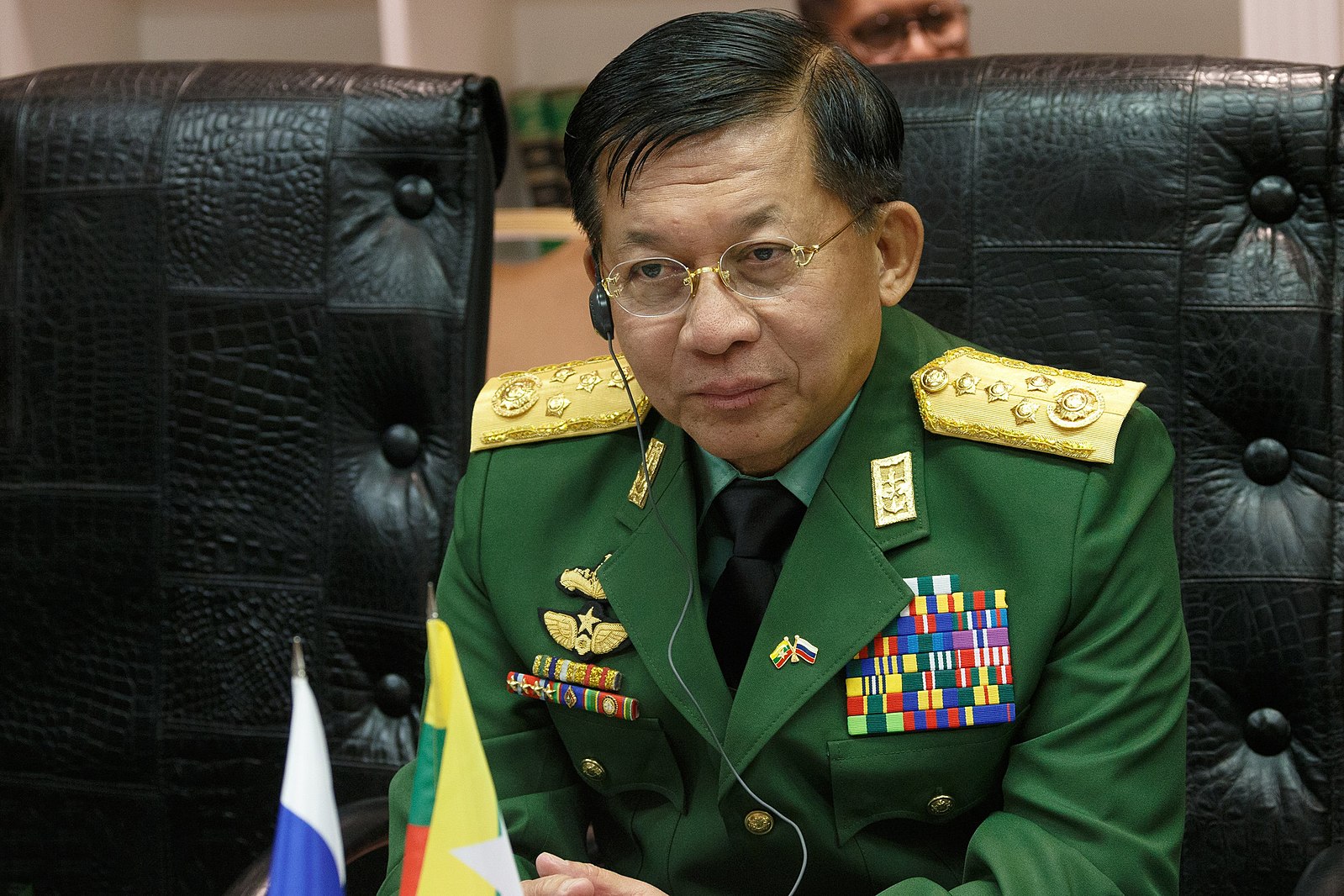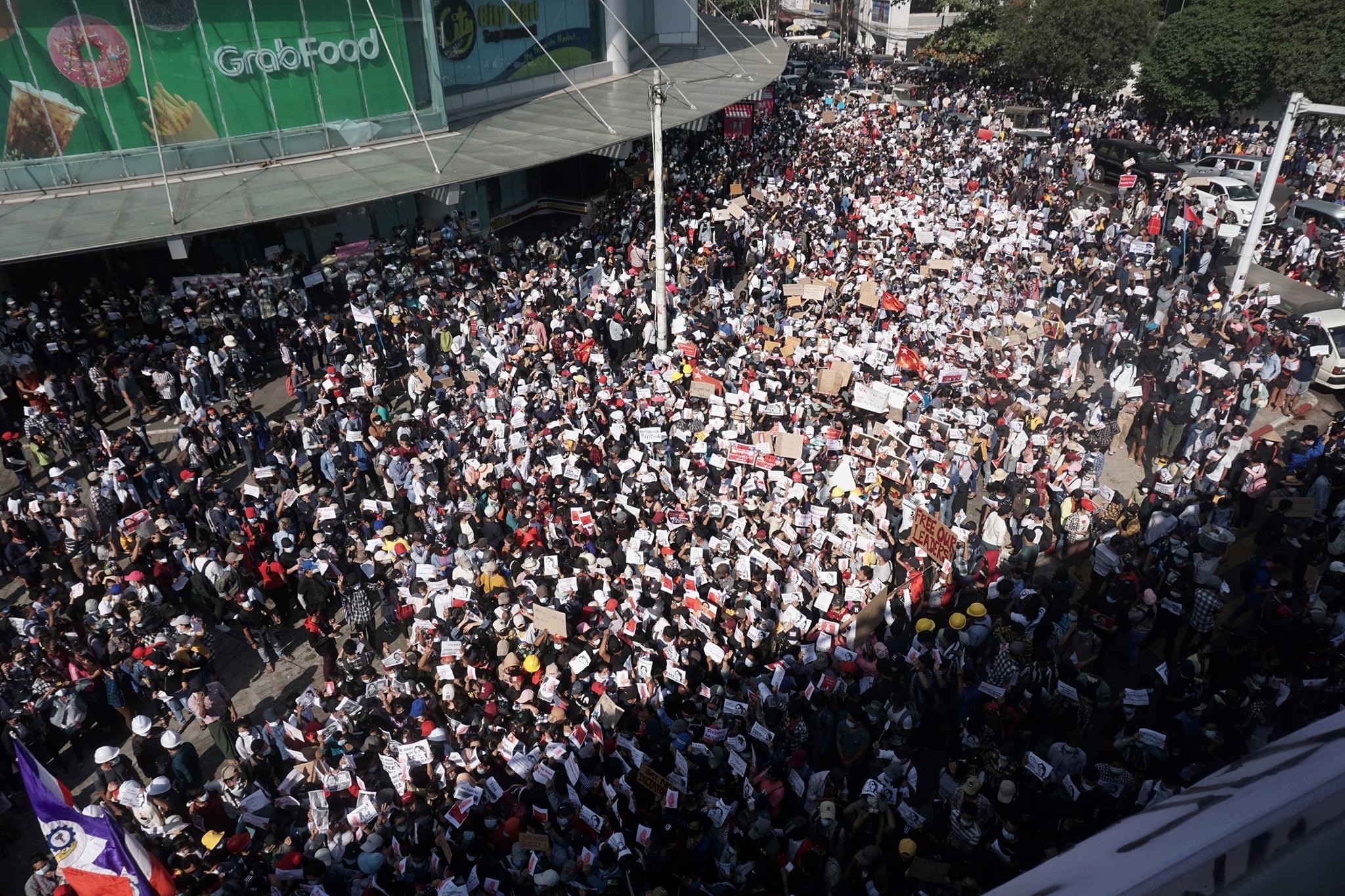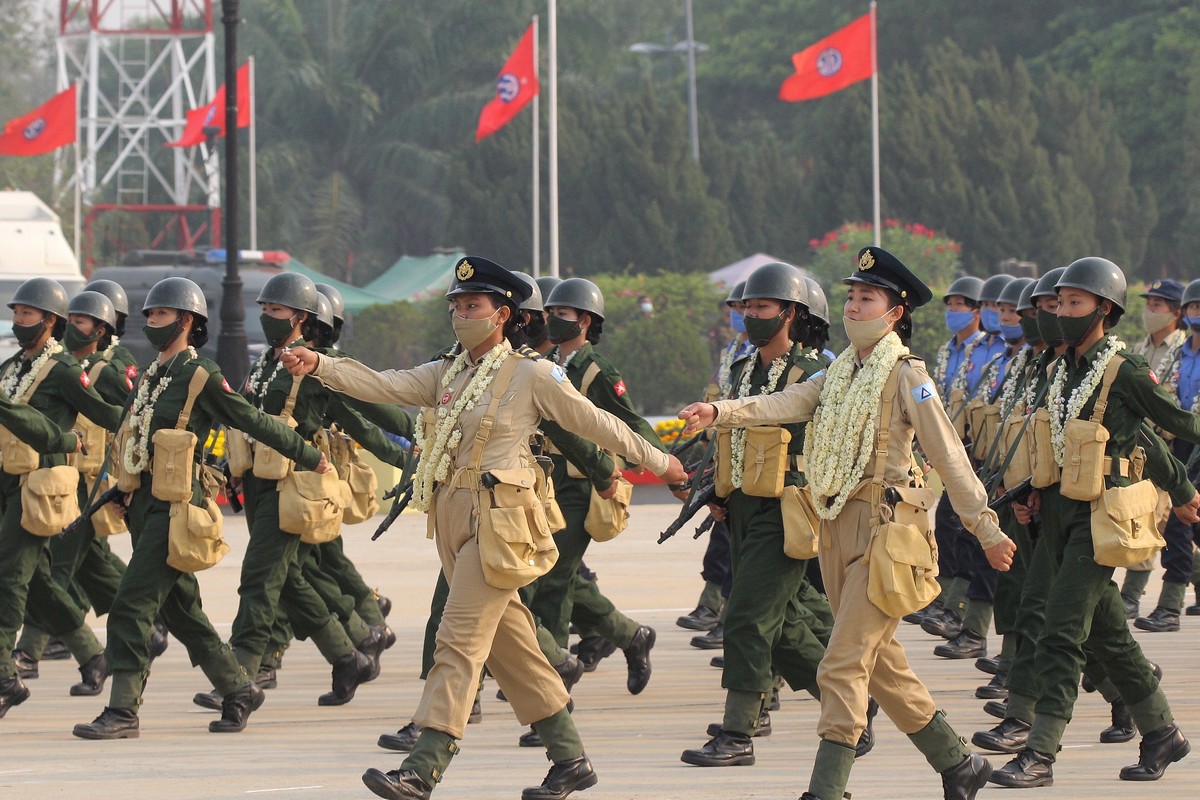We spoke to Dr. Jonathan Saha of the University of Durham on Myanmar, the violence of the current coup, and the fascist nature of Myanmar’s Military: The Tatmadaw. Below please find our conversation and please share or get involved if you’d like to build solidarity for Myanmar and its protesters.
Asia Art Tours: Looking at Myanmar’s protests through the anti-fascist lens of ‘No Parasan’ when ‘democratic’ governments like the US or UK, work with explicitly non-democratic countries (like China or Singapore) who then support the fascist governments of a post-coup Myanmar, what larger questions does this raise about the current nature of global liberal democracy?
Jonathan Saha: For me, the utility in naming the Tatmadaw’s coup a fascist regime is twofold. Firstly, I believe it’s accurate. The military’s ideology is explicitly premised on an ethnically-supremacist hierarchy that fetishizes the territorial integrity of the nation and yearns for a totalitarian ideal of national harmony. Its deeply-conservative, racist, misogynistic, homophobic, religiously-sectarian social mores buttress its hollow and fanciful claims to be representing an autochthonous community. Its extreme deployment of political violence on the flimsiest of premises is integral to bolstering these weak ideological claims. Officers and rank-and-file in the Tatmadaw are held together through a grim valorisation of sacrifice and loyalty, and the notion of shared privations—although, of course, the Generals do not actually share in this. Finally, the separation between the military and state institutions is blurred, at best. This means that through state enterprises, the Generals deploy a gatekeeper, corporatist strategy to parasitically accumulate capital. If this can’t be called fascism, then I am not sure what can be. And this is before engaging in a historical analysis of its roots in Japanese fascism. But quite beyond this analytical approach, Burmese civil disobedience activists, including deserting officers, have named it fascist. As an outside commentator, I think it’s essential that I amplify the perspectives of Burmese activists.
The second reason for naming the military regime fascist is that it pushes back against Orientalising coverage of the coup in the West that frames it as a problem of “backward” places, inherently different to the “developed” world. It indicates that the ideological architecture of the Tatmadaw is not alien to Europe or North America. This should be immediately apparent, not only historically, but in the present: evidenced by the rise of the far right as political movements and, on occasions, an electoral force, as well as the wider, marked rightward-shift in political rhetoric and policies. And while of a different order and scale, police brutality, imprisonment, poverty, and other forms of marginalisation in the West similarly reinforce racialized hierarchies and fissures. Naming the Tatmadaw fascist guards against indifference to the antifascist struggle in Myanmar itself, and against complacency about the security and efficacy of liberal democracy in combatting the rising tide of fascism elsewhere in the world.
For me, the utility in naming the Tatmadaw’s coup a fascist regime is twofold. Firstly, I believe it’s accurate. The military’s ideology is explicitly premised on an ethnically-supremacist hierarchy that fetishizes the territorial integrity of the nation and yearns for a totalitarian ideal of national harmony. Its deeply-conservative, racist, misogynistic, homophobic, religiously-sectarian social mores buttress its hollow and fanciful claims to be representing an autochthonous community.
 Photo of murdered protester Kyal Sin, also know as Angel or (邓家希) who has become a martyr and symbol of these protests. Her tee-shirt reads ‘ everything will be OK’. PHOTO CREDIT: Wikipedia
Photo of murdered protester Kyal Sin, also know as Angel or (邓家希) who has become a martyr and symbol of these protests. Her tee-shirt reads ‘ everything will be OK’. PHOTO CREDIT: Wikipedia
Asia Art Tours: You have shared on social media, calls for companies like Adidas, Zara & Lidl to allow garment workers to strike for the CDM movement without repercussion. Justice for Myanmar has also worked diligently to highlight links between capital and the Tatmadaw. How do we see capital originating from democratic countries as implicated in Myanmar’s violence? And are their differences in the degree of implication between capital that originates in democracies and capital originating in more explicitly authoritarian countries such as China?
Jonathan Saha: The so-called (and ultimately ill-fated) “democratic transition” in Myanmar succeeded in bring wider networks of capital into Myanmar—part of a longer story of “accumulation by dispossession” by which new sites of extraction, production and (to a lesser extent) consumption are perpetually incorporated into global capitalism. State enterprises, particularly oil and gas, were central to the Generals ostensibly liberalising extractive sectors of the economy while in fact fostering ties that entrenched their own privileged positions and perpetuated their own enrichment. A great deal of focus has been on China, justifiably given the CCP’s callous reaction to threats to some of its economic interests in the country and its obstructive stance on the United Nation’s Security Council. But as you suggest in your question, the Tatmadaw’s coffers are enlarged though capital from democratic regimes too.
There may be differences in the implications of this, and there has been some good commentary on the differential responses from businesses connected to Myanmar. Here I’d just like to highlight how capital from the West vicariously draws many ordinary people into these relations. Take pension schemes, for example, or more specifically, take my own pension scheme, the Universities Superannuation Scheme (USS), which is the UK’s largest private pension fund. Among USS’s equity holdings are a number of companies with direct relationships with the military, including the oil and gas giants Chevron, Total, and Royal Dutch Shell. These are only part of the multibillion-pound fund’s portfolio of investments, and Myanmar represents only part of these corporations’ global activities, but conversely these relationships are crucial to the military regime itself. I’m sure that most members of the scheme would be horrified to think that their futures are being secured through investments that support the Tatmadaw; that a fraction of their salaries is being indirectly channelled into the pockets of these fascist Generals. Divestment must be part of the solidarity campaign against the coup. It also underscores the complementarity of divesting from fossil fuels and campaigning for ethical investment policies.
The second reason for naming the military regime fascist is that it pushes back against Orientalising coverage of the coup in the West that frames it as a problem of “backward” places, inherently different to the “developed” world. It indicates that the ideological architecture of the Tatmadaw is not alien to Europe or North America.
 (General Ming Aung Hliang, whose bloody suppression of Myanmar’s election results and CDM movement, will make him one of this century’s most despised villians. PHOTO CREDIT: Wikipedia)
(General Ming Aung Hliang, whose bloody suppression of Myanmar’s election results and CDM movement, will make him one of this century’s most despised villians. PHOTO CREDIT: Wikipedia)
Asia Art Tours: Looking at what workers have had to endure in Myanmar is both inspiring and terrifying. From factory workers being locked inside so they cannot protest to striking workers being explicitly targeted and killed by the Tatmadaw to break up the CDM’s General Strike. Do you see what Myanmar’s workers have organized or endured as something with which global labor solidarity can be built? Could we (try) to build a global strike movement for Myanmar?
Jonathan Saha: The resolution of workers’ strikes in Myanmar is incredible. The breadth of the general strike remarkable, from garment workers through to civil servants. The Burmese garment workers’ expressions of solidarity with striking Amazon workers speak to the global resonances of this movement. It has put paid to the belief that female-dominated factory labour regimes located in the Majority World equates to a more pliant workforce. But as the testimonies of these union organisers highlight, building this power over the last few years prior to the coup was hard fought. Organising workplaces is difficult. Gestures to a global strike, while powerful in the possibilities that they might auger, often remain gestures. Meanwhile, there is solidarity work going on across trade unions that can provide material support for the general strike in Myanmar. This might be through unions lobbying governments, denying service to organisations supporting the military, making donations to strike funds, or fighting for divestment from corporations that are in relationships with the regime.
A great deal of focus has been on China, justifiably given the CCP’s callous reaction to threats to some of its economic interests in the country and its obstructive stance on the United Nation’s Security Council. But as you suggest in your question, the Tatmadaw’s coffers are enlarged though capital from democratic regimes too.
 (Protesters against the Tatmadaw in Yangon. PHOTO CREDIT: Wikipedia)
(Protesters against the Tatmadaw in Yangon. PHOTO CREDIT: Wikipedia)
Asia Art Tours: And for the terrifying aspect of this question, in what ways (both abstract and concrete) will the violence that Myanmar’s workers have endured slowly spread & become conditions that ALL workers (to varying degrees) may have to endure? Do you see the violence of Myanmar become a ‘systemic feature’ of global capitalism?
Jonathan Saha: As for whether the violence that the military have deployed against strikers might foreshadow a global regime for terror, this would be a terrifying prospect. I would want to temper this bleak outlook by noting that historically labour movements have faced these threats in many circumstances. The notion of “accumulation by dispossession” holds that violence is intrinsic to global capitalism, and analyses of racial capitalism further refine this analysis to show the structural racism of this violence. So, I don’t think the military’s violent repression connotes any new systemic mode of oppression. It might, however, conversely reveal the limits to its effectiveness, revealing their inability to command labour power. For those outside the country, we can put pressure on the brands such as Adidas, who present themselves as ethical capitalists but who have done little to protect the Burmese workers who make their products in Myanmar. Capitalism is never a monolithic, stable force. I think what I am advocating for is a nimble, strategic internationalism orientated towards defending and expanding workers’ rights.
The resolution of workers’ strikes in Myanmar is incredible. The breadth of the general strike remarkable, from garment workers through to civil servants. The Burmese garment workers’ expressions of solidarity with striking Amazon workers speak to the global resonances of this movement. It has put paid to the belief that female-dominated factory labour regimes located in the Majority World equates to a more pliant workforce. But as the testimonies of these union organisers highlight, building this power over the last few years prior to the coup was hard fought.
 (Myanmar’s Tatmadaw celebrating 2021 Armed Forces Day and successful coup over the democratically elected NLD government. PHOTO CREDIT: Wikipedia)
(Myanmar’s Tatmadaw celebrating 2021 Armed Forces Day and successful coup over the democratically elected NLD government. PHOTO CREDIT: Wikipedia)
Asia Art Tours: When it comes to left internationalist perspectives, I see Fanon’s legacy of hard-earned wisdom being overshadowed by the state. In my estimation far too many leftists cannot kill the ‘CIA’ in their head, and ONLY associate ‘intervention’ with state actors/actions, rather than the legacy that Fanon, Che, or Kathleen Cleaver outlined for us: building an international revolution of international revolutionaries.
How can we fight against the Neo-colonialists of the Tatmadaw while not reverting to colonialism ourselves? And what insights do past international revolutionaries have for us today regarding solidarity for Myanmar, outside of the framework of the Nation-State?
Jonathan Saha: As someone whose academic training was steeped in postcolonial theory, I think it is about allyship and positionality. There isn’t space to really get into this at length, but in brief, activists in the West can’t theorise our power and privilege away. A candid assessment of one’s own context, resources, and relations needs to be part of engaging in any advocacy. This should be an empowering process.
It’s worth noting that there have long been strains in academic scholarship that have used ostensibly anti-imperial, postcolonial approaches (superficially, in my view) to attack democracy movements and advocacy. Some similar bad takes have emerged online over the last few weeks too. These positions should be seen for what they are: culturally essentialising apologia for military rule. More generally, taking a state-centric approach to framing interventions in Myanmar will always run the risk of marginalising the “internal” colonialism of the military’s wars in the country’s border-worlds. Internationalism is not inherently imperialist.
For those outside the country, we can put pressure on the brands such as Adidas, who present themselves as ethical capitalists but who have done little to protect the Burmese workers who make their products in Myanmar. Capitalism is never a monolithic, stable force. I think what I am advocating for is a nimble, strategic internationalism orientated towards defending and expanding workers’ rights.
 (CDM protests in Mandalay, protesting against the Fascist Tatmadaw Military Junta. PHOTO CREDIT: Wikipedia)
(CDM protests in Mandalay, protesting against the Fascist Tatmadaw Military Junta. PHOTO CREDIT: Wikipedia)
Asia Art Tours: In watching global protest footage or viewing photos, I feel a deep ‘spiritual nausea’ from the lack of biological life except for humans. From BLM to Extinction Rebellion, to Hong Kong to The Farmer’s protests to Myanmar… outside of rare shots of protesters consoling/being consoled by domesticated animals ( domestic cats/dogs or pigeons) there are NO other animals or even plants. It’s just concrete and bullets and asphalt and fire.
A focal point of your scholarship is on the relationship between colonialism and animals. Could I ask you to explain if you see a connection to the absence of biological life in human spheres and the cruelty of so many systems of dominance in the world today? How does the ‘absence’ of nature from our lived experiences connect (if at all) to our global lack of justice and democracy?
Jonathan Saha: Like you, I have seen few images of animals (other than humans) involved in these struggles. There have been a few images of domesticated elephants participating in the demonstrations, and these giants have also long provided logistical support for Myanmar’s ethnic armed organisations. But the ecological narrative is there, even if it is minor theme in the story of the Spring Revolution. Early into the coup there were reports of the military frantically logging timber to mitigate the effects of the strike on their financial resources. And their aerial bombardment of the Salween Peace Park in Kawthoolei—an initiative that marries indigenous rights activism with grass-roots environmentalism—also reveals the deeper ecological stakes of the struggle. That the fossil fuel industry is among the most pivotal backers of the military is, I would argue, telling.
Coming back to elephants, advocates for rewilding have emphasised the importance of indigenous handlers, and civil society dialogue and oversight. In addition, to avoid conflict with humans the protection and release of elephants necessitates poverty alleviation schemes, as research shows this to be the main factor in these conflicts in Myanmar. To cut to the chase, the fate of Myanmar’s precariously employed working elephants in the country’s unsustainable timber industry is linked to the revolution. Recognition of ethnic minority rights, the establishment of spaces for participatory democratic politics, and the pursual of egalitarian social policies will open new futures for elephants to perhaps return to their ancestral forests and support the flourishing of Myanmar’s forests. The revolutionary axiom, “there is a world to win”, includes within it the teeming variety of the Myanmar’s denizens.
As someone whose academic training was steeped in postcolonial theory, I think it is about allyship and positionality. There isn’t space to really get into this at length, but in brief, activists in the West can’t theorise our power and privilege away. A candid assessment of one’s own context, resources, and relations needs to be part of engaging in any advocacy. This should be an empowering process.
 (Lino print made by Dr. Saha, demanding ‘No Parasan‘ in opposition to the Fascism of Myanmar’s Tatmadaw. PHOTO CREDIT: Dr. Jonathan Saha)
(Lino print made by Dr. Saha, demanding ‘No Parasan‘ in opposition to the Fascism of Myanmar’s Tatmadaw. PHOTO CREDIT: Dr. Jonathan Saha)
For more w. Dr. Saha please read his incredible essay on Myanmar, the Tatmadaw and ‘Karaoke Fascism’ .
